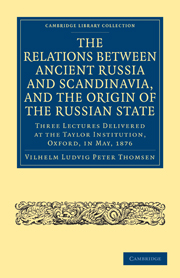 The Relations between Ancient Russia and Scandinavia, and the Origin of the Russian State
The Relations between Ancient Russia and Scandinavia, and the Origin of the Russian State Book contents
- Frontmatter
- PREFACE
- Contents
- LECTURE I ON THE INHABITANTS OF ANCIENT RUSSIA, AND THE FOUNDATION OF THE RUSSIAN STATE
- LECTURE II ON THE SCANDINAVIAN ORIGIN OF THE ANCIENT RUSS
- LECTURE III ON THE DENOMINATION AND HISTORY OF THE SCANDINAVIAN ELEMENT IN RUSSIA
- APPENDIX: OLD RUSSIAN PROPER NAMES
- ADDITIONS
- INDEX
LECTURE III - ON THE DENOMINATION AND HISTORY OF THE SCANDINAVIAN ELEMENT IN RUSSIA
Published online by Cambridge University Press: 29 August 2010
- Frontmatter
- PREFACE
- Contents
- LECTURE I ON THE INHABITANTS OF ANCIENT RUSSIA, AND THE FOUNDATION OF THE RUSSIAN STATE
- LECTURE II ON THE SCANDINAVIAN ORIGIN OF THE ANCIENT RUSS
- LECTURE III ON THE DENOMINATION AND HISTORY OF THE SCANDINAVIAN ELEMENT IN RUSSIA
- APPENDIX: OLD RUSSIAN PROPER NAMES
- ADDITIONS
- INDEX
Summary
In the preceding Lecture I reviewed the evidence which can be adduced from other sources to confirm Nestor's account of the foundation of the Russian state, and I think that we have thus obtained a complete corroboration of his statement as to the Scandinavian origin of the ancient Russ. I have referred to some of the arguments used by the anti-Scandinavianists to weaken the power of the different proofs produced by their adversaries; but, on the other hand, I hope I have shown that they are far from having succeeded in their attempts. Especial attention has been called to the linguistical evidence, founded upon the proper names which occur in early Russian history, and upon the few words which have been handed down to us of the language of the ancient Russ (the names of the Dnieper rapids); this evidence seems to be so decisive, that the opponents of the Scandinavian theory have hardly made any serious attempt to gainsay it.
To show the improbability of Nestor's account, the anti-Scandinavianists have taken particular pains to prove the existence of the Russ as a distinct tribe in Russia long before the year stated by Nestor. I have mentioned the most important of these presumed proofs, and believe I have shown how untenable they are: I will only add, that even if such evidence could be admitted, it would only prove that the date given by Nestor is incorrect; while it would not touch the question of the original nationality of the Russ, a fact which is independent of chronology, to a certain extent at any rate.
- Type
- Chapter
- Information
- The Relations between Ancient Russia and Scandinavia, and the Origin of the Russian StateThree Lectures Delivered at the Taylor Institution. Oxford, in May, 1876, pp. 87 - 130Publisher: Cambridge University PressPrint publication year: 2010First published in: 1877


